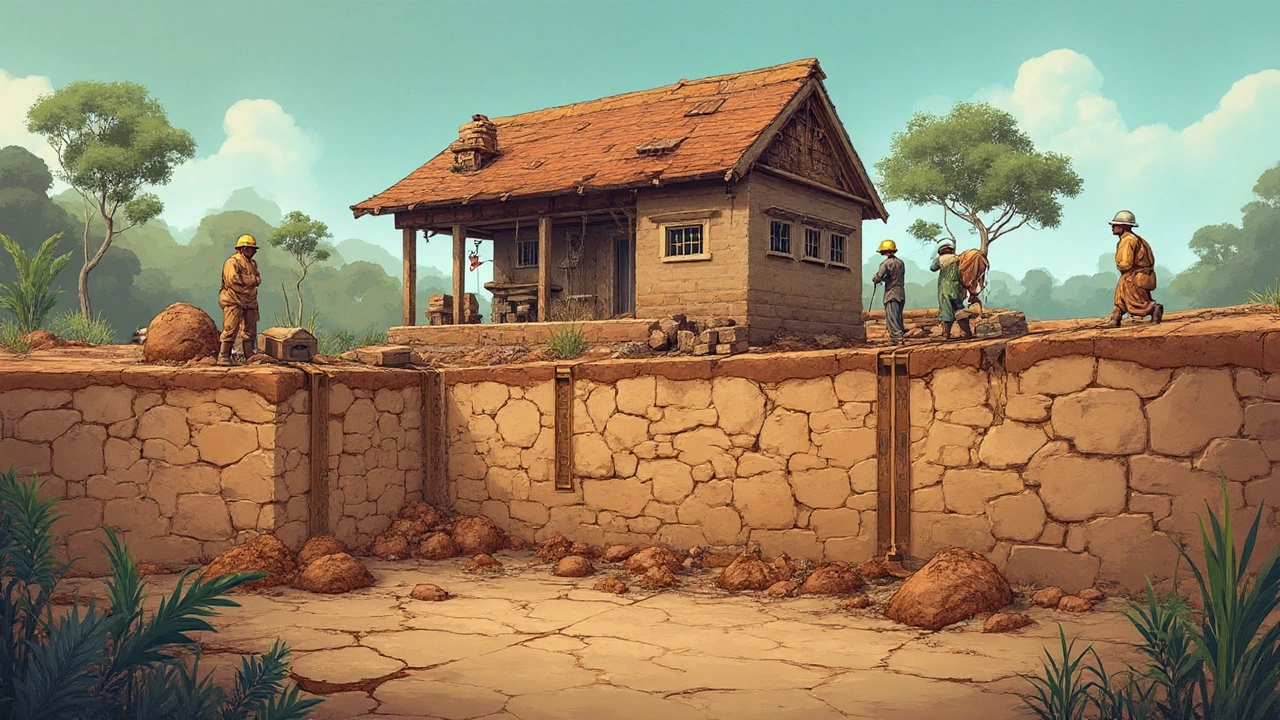Here’s a wild, but true fact: more homes in the U.S. need foundation repair each year than have house fires or floods. Most people won’t even notice the signs. And when they finally do, the fix sometimes involves big machinery, huge bills, and weeks of disruption. Major foundation repair is not just about patching a crack in the basement: we’re talking about stopping your house from slowly sinking, tilting, or literally pulling apart. Some folks act fast, others wait, convinced it’s all just part of “settling.” Guess which group pays more—by a long shot?
What Makes Foundation Repair "Major"?
So what sets apart minor patch-jobs from the kind of major foundation repair that makes homeowners lose sleep? The line is pretty clear: if the issues threaten your home’s structural safety or can’t be solved without significant intervention—or both—it’s major. Surface cracks? Often cosmetic. But horizontal cracks wider than a pencil, walls bowing in or out, doors that won’t close, or floors sloping? Those add up to a major fix. Think of a few bricks coming loose versus an entire corner of your house slowly sinking underground.
The heavy hitters of foundation trouble usually involve one (or more) of these:
- Extensive wall or floor cracking (not hairline, but wide enough to fit a quarter or worse)
- Sagging, sloping, or bouncy floors above the crawl space or basement
- Foundation walls bowing in or out (sometimes seen as a “bulge” in the wall)
- Entire sections of the house noticeably settling (think doors that stick, big gaps around windows, siding splitting apart, or diagonal cracks above windows and doors)
- Water getting in through the foundation, not just the basement, after heavy rain or melting snow
If your home checks even one of these boxes, you’re not dealing with a weekend DIY project. By the time you see one of these warning signs, the foundation has already shifted or been damaged enough that serious work—or “major repair”—is the only real way to stop the problem from escalating.
The Most Common Major Foundation Repair Methods
There’s a good reason most people only hear about foundation repair when things get really bad—the big fixes often involve stuff you’d never dream of doing yourself. Depending on where you live and your home’s design, here’s what the repair company might suggest:
- Piering (or underpinning): Steel piers or concrete pilings driven deep beneath the house to lift sunken sections and keep them stable. This is what they do when a home is sinking—often caused by poor soil or too much water shifting the ground.
- Wall Anchors or Bracing: Huge steel rods or anchor plates are installed inside and outside foundation walls to pull bowing walls back into place, or at least keep them from moving further. Sometimes, interior “I-beams” are used instead.
- Slabjacking (Mudjacking): For homes with concrete slabs, this method involves pumping a special mixture underneath to float sunken parts of the floor back up. But it only works if soil conditions haven’t shifted a lot beneath the whole house.
- Foundation Replacement: In worst-case scenarios, the whole foundation may need to be rebuilt. This is the “sledgehammer” fix—sometimes, it means literally lifting the house, demolishing the foundation, and pouring a new one underneath.
- Drainage Corrections: If water’s the reason your foundation’s moving, massive overhauls to the property’s drainage system might be part of the fix—think French drains, sump pumps, grading, or even moving landscaping away from the house.
Each of these methods is designed for different types of foundation issues. Here’s a quick comparison:
| Method | Best For | Typical Cost (2024 USD) | Time Needed |
|---|---|---|---|
| Piering (Underpinning) | Severe settling/sinking | $10,000 - $50,000+ | 1-3 weeks |
| Wall Anchors/Bracing | Bowed foundation walls | $4,000 - $20,000 | Several days to 2 weeks |
| Slabjacking | Sunken concrete slabs | $3,000 - $12,000 | 1-2 days |
| Foundation Replacement | Total foundation failure | $35,000 - $150,000+ | 3-8 weeks |
Notice how the worst fixes take the longest and do the most damage to your wallet. And none are the kind you want to save money on by hiring your cousin who “knows concrete.”

Biggest Causes of Major Foundation Damage
Let’s bust a myth: most major foundation problems don’t come from ancient, crumbling houses. Newer homes—especially those built after the 1970s—face plenty of risk, too. The big problem is usually water or dirt (or both). Soil that swells when it gets wet and shrinks when it dries can move whole houses over the years. One Texas study found that 60% of homes built on “expansive” clay had significant foundation cracks within 25 years.
- Poor Drainage: Gutters don’t direct water away from the house. Downspouts dump against the foundation. The yard slopes inward instead of away. Water pools, softens the soil, and—bam—the house starts to move.
- Problem Soils: Clay soils are the worst since they expand and contract the most. Sandy soil usually drains better, but if it erodes, it leaves behind air pockets underneath a slab, which brings trouble of its own.
- Tree Roots: That old oak tree looks great… but its roots are sucking moisture from the soil right under the house, especially in dry seasons. That causes uneven drying, which means uneven settling.
- Poor Construction: Cheap foundations, improperly compacted fill dirt, or shortcuts when pouring concrete often don’t make themselves known until years later—when cracks, settling, and shifting reveal themselves.
- Earthquakes or Drought: Sudden natural events that rapidly shift the ground under a home. Even a small local tremor can snap old, brittle foundations—sometimes the first time you see a real issue is after an unusual weather event.
Want a rough test for risk? Find out what kind of soil is under your house. Expansive clay? Watch for signs every spring and fall. Sandy or loamy? Still keep an eye out after big storms, but the risk is a bit less.
Spotting Major Issues Early: What to Watch For
Most major foundation repairs could have been much cheaper if the signs had been caught earlier. Don’t trust home inspectors alone—even the most experienced ones sometimes overlook foundation signals, especially if the basement or crawlspace is finished and the concrete’s covered up. You want to play detective yourself, every few months.
- Look for new cracks above windows or doors that start small but get longer or wider month to month.
- If an interior door sticks, see if the gap at the top or bottom is widening—a sure sign something underneath moved.
- Walk the perimeter and look at the foundation. Are there stair-step cracks running up the bricks or blocks?
- Use a level or marble on upstairs floors. Rolling toward one side? Time for a closer look downstairs.
- Lots of spiderweb-thin cracks aren’t a big deal, but two or three big, wide cracks in one area? Not normal. Same goes for walls bowing even a little—take a yardstick and see if the wall curves in or out.
- Ever walked into your basement after heavy rain and suddenly stepped in water? Don’t let water in the basement go unchecked, even if it only happens once. Moisture shortens a foundation’s life like nothing else.
An overlooked fact: the most expensive fixes almost always come from problems ignored for months or years. If you see a new foundation crack and aren't sure how long it's been there, take a picture with your phone, set a calendar reminder, and compare next month. Movement? Call a pro. No change? Still worth keeping an eye on, but you might dodge a big bill.

Costs, Insurance, and When to Call a Pro
The big question: how much? According to a 2024 industry survey, “major” foundation repairs average between $12,000 and $65,000 in the U.S., but a full rebuild (tear out and pour a new foundation) can cost more than $150,000 depending on your region, house size, and accessibility for heavy equipment. Hidden costs? Temporary evacuation, moving furniture, restoring finished basements, re-landscaping—sometimes the fixes cost as much as the repair itself.
Major foundation repair isn’t covered by standard home insurance. Almost no regular homeowner policy will write a check for simple settling, natural shifting, or soil problems. Earthquake coverage is a separate policy, and even flood insurance rarely pays for structural fixes. What can help? Some home warranties, or rare cases where builder negligence or defective construction is proven in court. But don’t bank on it—most folks are paying out of pocket or getting financing through home improvement loans.
If a structural engineer tells you it's time for “major repair,” don't put it off. Waiting can drive up costs fast. Contractors say it’s common for a small fix to balloon into something huge in just one or two rainy seasons. Always get at least two opinions (not just contractor quotes, but actual engineering reviews)—an engineer’s report, which costs around $400–$800, is worth every penny to avoid getting upsold on unnecessary work.
- Get the foundation issue documented ASAP, so you have proof when reselling your house. Fixed foundations with paperwork sometimes even add to a home’s long-term value—buyers trust repairs done right.
- If you ever suspect hidden water leaks are making your problems worse, run a simple test: turn off all water-using appliances, then watch your water meter. If it still ticks up, hunt down those leaks immediately.
- Prioritize grading and basic gutter maintenance—redirecting water away can stop 70% of future issues, according to data from the International Association of Certified Home Inspectors.
Feeling overwhelmed? That’s pretty normal when serious repairs are on the table. But the sooner you act, the less you’ll pay—and the more likely you can stop small annoyances from turning into true disasters.

Written by Fletcher Abernathy
View all posts by: Fletcher Abernathy